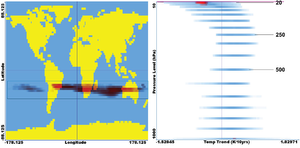Information
- Visibility: hidden
- Publication Type: Journal Paper (without talk)
- Workgroup(s)/Project(s): not specified
- Date: April 2010
- Journal: Journal of Atmospheric and Oceanic Technology
- Number: 4
- Volume: 27
- Pages: 667 – 679
Abstract
In atmospheric and climate research, the increasing amount of data available from climate models and observations provides new challenges for data analysis. We present interactive visual exploration as an innovative approach to handle large datasets. Visual exploration does not require any previous knowledge about the data as is usually the case with classical statistics. It facilitates iterative and interactive browsing of the parameter space in order to quickly understand the data characteristics, to identify deficiencies, to easily focus on interesting features, and to come up with new hypotheses about the data. These properties extend the common statistical treatment of data, and provide a fundamentally different approach. We demonstrate the potential of this technology by exploring atmospheric climate data from different sources including reanalysis datasets, climate models, and radio occultation satellite data. Results are compared to those from classical statistics revealing the complementary advantages of visual exploration. Combining both, the analytical precision of classical statistics and the holistic power of interactive visual exploration, the usual work flow of studying climate data can be enhanced.Additional Files and Images
Weblinks
BibTeX
@article{Ladstaedter-2010-exp,
title = "Exploration of Climate Data Using Interactive Visualization",
author = "Florian Ladst\"{a}dter and Andrea K. Steiner and Bettina C.
Lackner and Barbara Pirscher and Gottfried Kirchengast and
Johannes Kehrer and Helwig Hauser and Philipp Muigg and
Helmut Doleisch",
year = "2010",
abstract = "In atmospheric and climate research, the increasing amount
of data available from climate models and observations
provides new challenges for data analysis. We present
interactive visual exploration as an innovative approach to
handle large datasets. Visual exploration does not require
any previous knowledge about the data as is usually the case
with classical statistics. It facilitates iterative and
interactive browsing of the parameter space in order to
quickly understand the data characteristics, to identify
deficiencies, to easily focus on interesting features, and
to come up with new hypotheses about the data. These
properties extend the common statistical treatment of data,
and provide a fundamentally different approach. We
demonstrate the potential of this technology by exploring
atmospheric climate data from different sources including
reanalysis datasets, climate models, and radio occultation
satellite data. Results are compared to those from classical
statistics revealing the complementary advantages of visual
exploration. Combining both, the analytical precision of
classical statistics and the holistic power of interactive
visual exploration, the usual work flow of studying climate
data can be enhanced.",
month = apr,
journal = "Journal of Atmospheric and Oceanic Technology",
number = "4",
volume = "27",
pages = "667--679",
URL = "https://www.cg.tuwien.ac.at/research/publications/2010/Ladstaedter-2010-exp/",
}


